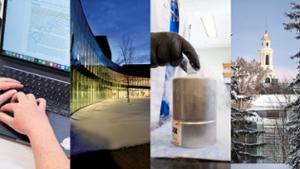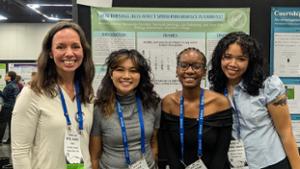
The trio of students were part of a larger physics research group who worked with Horowitz on coding mechanical resonator networks and creating a microfluidic device that can sort microscopic diamond crystals by their optical characteristics. Conti, Kannan, and Petro’s project similarly got microscopic as they examined cellular motion.

“There are a lot of things happening inside cells that we don’t understand the physics of yet,” Conti explained. The group’s goal was to use an artificial cell to replicate and study subdiffusion and superdiffusion, two types of cellular motion that don’t quite follow the laws of physics. Using artificial cells to observe cellular physics was an endeavor started by Horowitz and a previous group of summer researchers. By adding polyethylene glycol, a long-chain polymer, the trio was able to slow down tracer particles and examine their movement.
“Learning how to focus on the different layers of fluorescent particles with a microscope was a wonderful experience,” said Petro, who joined the research team to refine her lab skills. Conti and Kannan similarly joined due to Horowitz’s lab environment. “She’s always been super open about research opportunities with her students,” Conti said. “I remember Viva [Horowitz] telling us, ‘come to me if you have problems. My job is to solve problems.’”
This didn’t mean the students were under Horowitz’s thumb, though. “I was expecting her to have us tow along behind her, but she actually let us loose,” Kannan said. “We had to figure out our goals and how to achieve them. That independence was really cool, and I love how self-starting the project became.”
“I gained a lot of confidence in myself that I can ask the right questions, I can contribute to scientific advancement.” - Maya Kannan ’25
The students soon discovered an obstacle in their research. They were seeing superdiffusion in samples where there should have been none; their tracking methodology simply wasn’t able to capture the tracer particles. “There were too many variables to tune the tracking to,” Conti said. The group realized they needed to scale back and reevaluate their tracking software.
However, this obstacle was a necessary learning curve. “Nobody has done what we’re doing before and that’s why it’s hard,” Kannan explained. “So, although we didn’t get the result we were looking for, we greatly improved this tracking software and still moved the project forward.
The group feels proud of their contribution: “As the summer went on, we were able to solve more and more of our problems,” Conti said. “Like Viva, we were becoming professional problem solvers.”
Looking ahead, the students hope that their innovations in microscopic tracking will help propel research on cellular physics forward. “I’m sure our contribution isn’t as elegant or concise as it could be,” Petro acknowledged, “but it helped us to better identify particles and that’s what really counts.”
Kannan echoed this: “Getting to advance the edge of what we know, it’s really fun!”

Posted August 26, 2024


